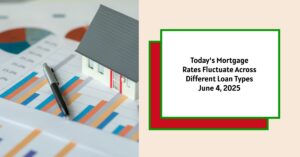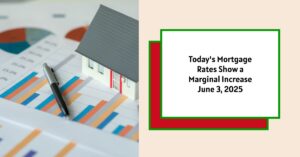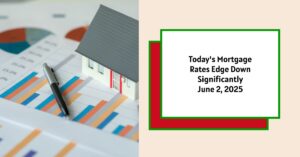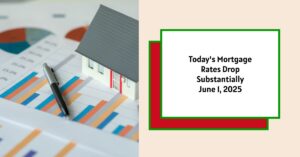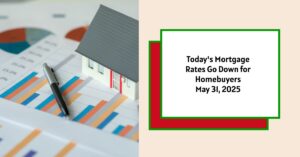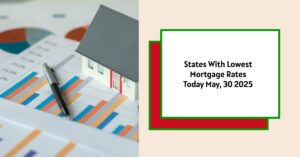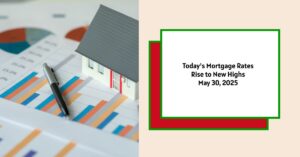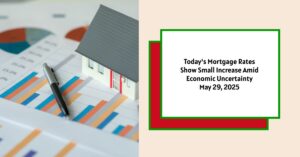On June 4, 2025, mortgage rates showed some slight upward movement for the national average 30-year fixed rate, climbing to 6.98%. This marks a minor increase of 1 basis point from the previous day but is still lower than the average rate from the week prior. For those looking to finance a home or considering a refinance, understanding these current mortgage trends is crucial. Let's dive deeper into the specifics of today's rates across different loan types and explore what these numbers mean for you.
Today's Mortgage Rates – June 4, 2025: Rates Fluctuate Across Different Loan Types
Key Takeaways:
- The national average 30-year fixed mortgage rate is currently 6.98%, up slightly from yesterday but down from last week.
- 15-year fixed mortgage rates have also seen a small increase, reaching 5.99%.
- Refinance rates for a 30-year fixed loan are at 7.25%, showing a modest rise from the previous day and a slight decrease from the week before.
- Rates vary significantly depending on the loan type (conforming, government, jumbo) and loan term.
- Experts predict mortgage rates in 2025 to potentially moderate slightly towards the end of the year.
Current Mortgage Rate Overview
Keeping a close eye on today's mortgage rates is essential whether you're a first-time homebuyer, looking to upgrade, or thinking about refinancing your existing mortgage. Several factors influence these rates daily, and even small fluctuations can impact your monthly payments and the overall cost of your loan over time. According to data released by Zillow, as of Wednesday, June 4, 2025, the national average for a 30-year fixed-rate mortgage has edged up.
It's interesting to note that while the daily change shows a slight increase, the weekly trend for the popular 30-year fixed rate indicates a decrease. This suggests that while there might be some short-term volatility, the overall direction in the past week has been slightly downward. For prospective homeowners, this could be a signal to keep monitoring the market closely for potential opportunities.
Let's break down the current mortgage rates by different loan types to provide a more detailed picture:
Conforming Home Loans
These are loans that meet specific standards set by Fannie Mae and Freddie Mac and are the most common type of mortgage. Here’s how the rates look for conforming loans:
| PROGRAM | RATE | 1W CHANGE | APR | 1W CHANGE |
|---|---|---|---|---|
| 30-Year Fixed Rate | 6.98% | down 0.03% | 7.40% | down 0.08% |
| 20-Year Fixed Rate | 6.83% | down 0.14% | 7.35% | down 0.04% |
| 15-Year Fixed Rate | 5.99% | down 0.07% | 6.27% | down 0.10% |
| 10-Year Fixed Rate | 5.89% | down 0.18% | 6.28% | down 0.19% |
| 7-year ARM | 7.56% | up 0.01% | 8.07% | up 0.15% |
| 5-year ARM | 7.26% | down 0.28% | 7.81% | down 0.16% |
| 3-year ARM | — | 0.00% | — | 0.00% |
As you can see from the table, the mortgage interest rates today for most conforming fixed-rate loans have decreased compared to last week. Adjustable-rate mortgages (ARMs) show a mixed bag, with the 7-year ARM seeing a slight increase while the 5-year ARM decreased. The 3-year ARM has no change reported. For borrowers considering the stability of a fixed rate, the current environment might be encouraging.
Government Home Loans
Government-backed loans, such as FHA and VA loans, often have different eligibility requirements and can be attractive options for certain borrowers. Here’s a look at their current rates:
| PROGRAM | RATE | 1W CHANGE | APR | 1W CHANGE |
|---|---|---|---|---|
| 30-Year Fixed Rate FHA | 7.75% | up 0.88% | 8.78% | up 0.87% |
| 30-Year Fixed Rate VA | 6.51% | up 0.03% | 6.71% | up 0.02% |
| 15-Year Fixed Rate FHA | 5.53% | down 0.05% | 6.49% | down 0.07% |
| 15-Year Fixed Rate VA | 5.99% | down 0.03% | 6.31% | down 0.06% |
Interestingly, while conforming loan rates mostly decreased over the past week, government loans show a more varied picture. The 30-year fixed FHA loan saw a significant increase, while VA loan rates experienced more modest increases for the 30-year term and decreases for the 15-year term. This highlights the importance of comparing rates across different loan types based on your individual circumstances and eligibility.
Jumbo Loans
Jumbo loans are for mortgages that exceed the conforming loan limits. These often come with slightly higher interest rates due to the larger loan amount and potentially higher risk for lenders. Here are the current rates for jumbo loans:
| PROGRAM | RATE | 1W CHANGE | APR | 1W CHANGE |
|---|---|---|---|---|
| 30-Year Fixed Rate | 7.45% | down 0.08% | 7.78% | down 0.17% |
| 15-Year Fixed Rate | 6.31% | down 0.24% | 6.54% | down 0.27% |
| 7-year ARM | 7.69% | 0.00% | 7.99% | 0.00% |
| 5-year ARM | 7.69% | down 0.56% | 8.24% | down 0.17% |
| 3-year ARM | — | 0.00% | — | 0.00% |
For jumbo loans, the trend over the past week has largely been downward for fixed-rate options, which could be good news for those looking to purchase higher-priced properties. The ARM rates are more stable, with the 7-year ARM remaining unchanged and the 5-year ARM showing a significant decrease.
Understanding Refinance Rates Today
For homeowners who already have a mortgage, refinance rates are just as important. Refinancing involves taking out a new mortgage to pay off your existing one, often with the goal of securing a lower interest rate, reducing monthly payments, or changing the loan term. Let's look at the current refinance rates as of June 4, 2025, according to Zillow.
The national average 30-year fixed refinance rate is currently 7.25%, up 4 basis points from the previous day but down 1 basis point from last week. Similarly, the national average 15-year fixed refinance rate is 6.12%, an increase of 6 basis points from yesterday. The 5-year ARM refinance rate remains steady at 7.97%.
Here's a more detailed breakdown of refinance rates by loan type:
Conforming Refinance Loans
| PROGRAM | RATE | 1W CHANGE | APR | 1W CHANGE |
|---|---|---|---|---|
| 30-Year Fixed Rate | 6.98% | down 0.03% | 7.40% | down 0.08% |
| 20-Year Fixed Rate | 6.83% | down 0.14% | 7.35% | down 0.04% |
| 15-Year Fixed Rate | 5.99% | down 0.07% | 6.27% | down 0.10% |
| 10-Year Fixed Rate | 5.89% | down 0.18% | 6.28% | down 0.19% |
| 7-year ARM | 7.56% | up 0.01% | 8.07% | up 0.15% |
| 5-year ARM | 7.26% | down 0.28% | 7.81% | down 0.16% |
| 3-year ARM | — | 0.00% | — | 0.00% |
Government Refinance Loans
| PROGRAM | RATE | 1W CHANGE | APR | 1W CHANGE |
|---|---|---|---|---|
| 30-Year Fixed Rate FHA | 7.21% | up 0.47% | 8.25% | up 0.49% |
| 30-Year Fixed Rate VA | 6.59% | up 0.10% | 6.71% | up 0.04% |
| 15-Year Fixed Rate FHA | 5.75% | down 0.09% | 6.72% | down 0.09% |
| 15-Year Fixed Rate VA | 6.03% | up 0.10% | 6.19% | down 0.03% |
Jumbo Refinance Loans
| PROGRAM | RATE | 1W CHANGE | APR | 1W CHANGE |
|---|---|---|---|---|
| 30-Year Fixed Rate | 8.63% | up 0.69% | 8.91% | up 0.58% |
| 15-Year Fixed Rate | 5.93% | down 0.67% | 6.16% | down 0.61% |
| 7-year ARM | — | 0.00% | — | 0.00% |
| 5-year ARM | 9.31% | up 0.62% | 8.90% | up 0.33% |
| 3-year ARM | — | 0.00% | — | 0.00% |
When considering a refinance, it's important to look beyond just the interest rate. Factors like closing costs and the length of your new loan term will also play a significant role in whether refinancing makes financial sense for you. As Zillow notes, you should ensure the new refinance interest rate is low enough to offset the costs associated with the new loan. Using a mortgage refinance calculator can be a helpful tool in making this determination.
Read More:
Mortgage Rates Trends as of June 3, 2025
Dave Ramsey Predicts Mortgage Rates Will Probably Drop Soon in 2025
Expert Perspectives on Mortgage Rates in 2025
Looking ahead, several organizations have offered their mortgage rates predictions for 2025. These forecasts can provide some context for understanding potential future trends.
The National Association of REALTORS® anticipates that the average mortgage rate will be around 6.4% in 2025. Their forecast also suggests a positive outlook for the housing market with increases in both existing and new home sales, as well as a moderate rise in median home prices.
Fannie Mae has revised its forecast, now expecting mortgage rates to end 2025 at 6.1% and 2026 at 5.8%, slightly lower than their previous predictions. They also foresee an increase in home sales and mortgage origination volumes.
The Mortgage Bankers Association (MBA) predicts that 30-year mortgage rates will remain near 6.7% through September 2025 and then slightly decrease to around 6.6% by the end of the year. This suggests a relatively stable home loan interest rate environment for the coming months.
Freddie Mac highlights that after higher-than-expected rates in 2024, the sentiment in early 2025 is that rates will likely remain higher for a longer period. However, they anticipate that even with potentially stable or modestly declining rates, increased amortization and a cooling of the rate lock-in effect could bring more inventory to the market and boost home sales compared to the previous year. They also expect a moderate pace of house price appreciation and an overall increase in both purchase and refinance volumes in 2025.
These expert forecasts suggest a general expectation of some moderation in mortgage rates throughout 2025, although the timing and extent of these decreases may vary. It’s important to remember that these are predictions and actual rates can be influenced by a wide range of economic factors.
What Does This Mean for You?
Understanding today's mortgage rates and the potential future outlook is crucial for anyone involved in the housing market. Whether you are looking to buy a new home or refinance your existing mortgage, keeping informed about these trends can help you make more strategic decisions. The slight decrease in many fixed rates compared to last week could be an encouraging sign, but the daily fluctuations remind us that the market is dynamic.
For potential homebuyers, it’s essential to consider your individual financial situation, including your credit score, down payment, and loan type, as these will significantly influence the rate you qualify for. Getting pre-approved for a mortgage can give you a clearer picture of the rates you can expect.
For current homeowners, evaluating whether now is a good time to refinance depends on several factors, including your current interest rate, the terms of your existing loan, and the potential savings versus the costs of refinancing. Even a small decrease in your interest rate could lead to substantial savings over the life of your loan.
Invest Smarter in a High-Rate Environment
With mortgage rates remaining elevated this year, it's more important than ever to focus on cash-flowing investment properties in strong rental markets.
Norada helps investors like you identify turnkey real estate deals that deliver predictable returns—even when borrowing costs are high.
HOT NEW LISTINGS JUST ADDED!
Connect with a Norada investment counselor today (No Obligation):
(800) 611-3060
Also Read:
- Will Mortgage Rates Go Down in 2025: Morgan Stanley's Forecast
- Expect High Mortgage Rates Until 2026: Fannie Mae's 2-Year Forecast
- Mortgage Rate Predictions 2025 from 4 Leading Housing Experts
- Mortgage Rates Forecast for the Next 3 Years: 2025 to 2027
- 30-Year Mortgage Rate Forecast for the Next 5 Years
- 15-Year Mortgage Rate Forecast for the Next 5 Years
- Why Are Mortgage Rates Going Up in 2025: Will Rates Drop?
- Why Are Mortgage Rates So High and Predictions for 2025
- Will Mortgage Rates Ever Be 3% Again in the Future?
- Mortgage Rates Predictions for Next 2 Years
- Mortgage Rate Predictions for Next 5 Years
- Mortgage Rate Predictions: Why 2% and 3% Rates are Out of Reach
- How Lower Mortgage Rates Can Save You Thousands?
- How to Get a Low Mortgage Interest Rate?
- Will Mortgage Rates Ever Be 4% Again?
